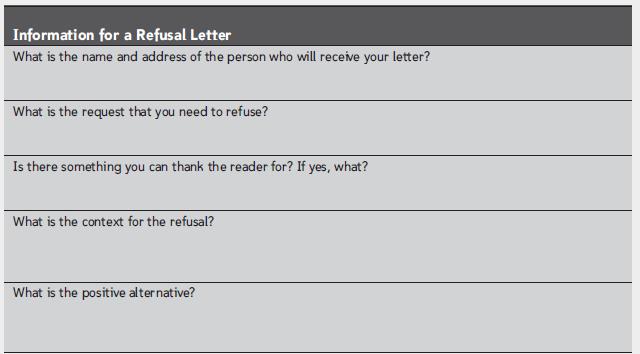You can use the refusal letter structure to help you write refusal letters in a wide range
Question:
You can use the refusal letter structure to help you write refusal letters in a wide range of situations—from business to personal. Think of a situation in which you need to say no to someone who has considerable emotional or financial investment in a positive outcome.
For example, you may need to say no to a community service group that has asked you to assist with an important fund-raising drive for which your skills are in great demand.
Follow the steps below to write your refusal letter so that it uses the five-paragraph structure, and then add an envelope and print a sheet of labels containing your name and address.
1. Complete the table below with the information you need to help you write the refusal letter. Note that you will need to make up information. Use fictitious but realistic details.

2. Create a new document in Word, and then save it as Refusal Letter.
3. Create an attractive letterhead using your own name and address information.
4. Include the current date below the letterhead and then enter the information for the inside address two lines below the date. Note that you can change the line spacing to 1.0 and remove After spacing so that the inside address information is singlespaced.
5. Include a salutation.
6. Start paragraph 1 by thanking the reader. For example, the opening to a letter related to a request for assistance at a fund-raising event could be: Thank you for asking me to run the Holiday Book Fair fund-raiser for Literacy Now. Follow this sentence with a sentence that extends goodwill.
7. In paragraph 2, provide the context for the refusal. Note that paragraph 2 is the most important (and the most difficult) paragraph to write in a refusal letter. Your goal is to lead the reader slowly toward the realization that you will be refusing the request.
You want the reader to say no to him or herself before you do and to recognize that your refusal is both fair and reasonable.
8. Write a third paragraph that says no politely and respectfully.
9. Write a fourth paragraph that provides the reader with a positive alternative. For example, you could offer to take on another role at a future event or recommend someone who can take your place.
10. Close positively with a request for the reader to contact you if he or she has further questions, and include your name in the complimentary closing.
11. Create an envelope for the letter, and then format the return and delivery addresses with the Calibri font and 11 pt. Format your name differently from the rest of the address information.
12. Save the document, and then print a copy of the envelope and letter.
13. Create a sheet of labels for your name and address (select Microsoft as the label vendor if it is not already selected, and then select the second listing for 30 Per Page in the Label Options dialog box). Format your name with a different font and a larger font size. Note that you may need to generate a few sheets of labels before you are satisfied with the placement of your name and address information on each label. Experiment with different font sizes and line breaks.
14. Save the label sheet as Refusal Letter Label Sheet, print a copy, and then close the document. Do not save any of the label sheets that you do not intend to keep.
15. Close the letter document.
Step by Step Answer:

New Perspectives Portfolio Projects For Business Communication
ISBN: 9781439037461
1st Edition
Authors: Carol M. Cram






